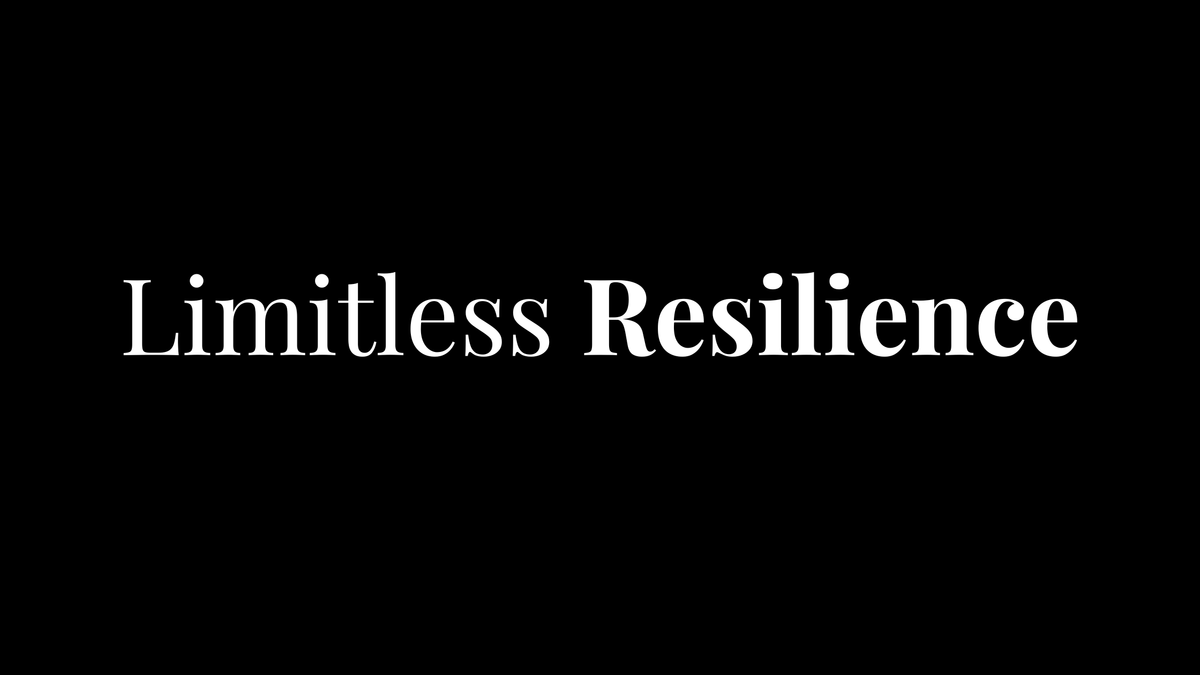Limitless Resilience: The Art of Rising Up Stronger
Feel like life's challenges keep pushing you back? Discover how to cultivate resilience that transforms setbacks into stepping stones and emerge stronger with every obstacle you face.

Challenges are inevitable, but how you respond to them defines your success. It's not about sidestepping failure—it's about rising stronger after each setback. Resilience is what separates those who push forward from those who quit.
I assure you, resilience doesn't come naturally to everyone, but the good news is that it's a skill you can build and strengthen over time. If you're ready to thrive through life's challenges, this step-by-step blueprint will show you exactly how to cultivate unshakable resilience.
Today's edition is about that critical skill we all need: building resilience that transforms setbacks into springboards. Because when you develop unshakable resilience, you don't just survive challenges—you use them to propel yourself forward.
WHY RESILIENCE MATTERS
Resilience is not just the ability to recover from setbacks, but to emerge stronger, wiser, and more capable than before.
For anyone on a journey of growth, resilience serves three essential functions:
- It transforms obstacles into opportunities. When you're resilient, challenges become valuable data points rather than defeating blows.
- It preserves your energy and momentum. Instead of draining months of productivity in recovery mode, resilience helps you process setbacks efficiently and keep moving forward.
- It builds sustainable success. The path to any meaningful achievement is paved with failures. Resilience ensures that these inevitable stumbles strengthen rather than derail you.
Think of resilience as the immune system of your success—it doesn't prevent challenges, but it determines how quickly and effectively you recover from them.
THE PILLARS OF UNSHAKABLE RESILIENCE
1. Reframe Setbacks as Lessons
You've heard it before: "It's not a failure; it's a lesson." But here's the truth—you need to actually believe it. Reframing setbacks is more than just a mindset shift; it's a strategic tool that will change how you approach obstacles. Instead of getting stuck in the "why me?" mentality, ask yourself:
- What can I learn from this situation?
- How can I use this experience to make better decisions next time?
Consider the story of Sara Blakely, founder of Spanx. She was turned down by countless manufacturers before one agreed to produce her prototype which originally looked like footless pantyhose with a unique design. Instead of seeing these rejections as failures, she viewed them as opportunities to refine her pitch and improve her product. Blakely said, "I had been selling fax machines door to door for seven years, and I had learned a lot about rejection and how to deal with people telling you no. It was a total training ground, because all I heard was no for the first two years of trying to get Spanx off the ground." Her resilience led to Spanx becoming a billion-dollar brand.

Think about a recent setback. Write down three things you learned from that experience. How can these lessons guide you moving forward?
Mentally Preparing for Setbacks: Before challenges arise, prepare your mind for them. Expect obstacles as part of the process, not a deviation from it. This simple mindset shift will help you move forward faster when things go off track.
2. Build Mental Toughness Daily
Resilience isn't built in a single moment of crisis. It's a muscle you strengthen daily. To build mental toughness, you must push yourself in small but significant ways regularly.
Daily Mental Toughness Routines
- Start Your Day with Intent: Before the day sweeps you away, take a moment to focus on one specific goal or challenge. Setting a clear intention helps you maintain focus throughout the day.
- Embrace Discomfort: Every day, choose one thing that pushes you outside your comfort zone. Whether it's a tough workout, taking on a daunting task, or having an uncomfortable conversation, challenging yourself consistently builds resilience.
- Journaling: If you're a writer, jot down the moments you feel tested. Reflect on how you handled those situations and how you can improve next time.
Pro Tip: Engage in practices like cold exposure (e.g., cold showers) or mental puzzles to push your boundaries. The more comfortable you get with discomfort, the more resilient you become in facing life's bigger challenges.
Micro-goals for Strengthening Mental Toughness Break down large challenges into micro-goals. Each small win reinforces your confidence and mental toughness. For example, if you're working on a large project, set daily milestones instead of focusing solely on the final outcome.
3. Practice Deep Self-Compassion
Being resilient doesn't mean being hard on yourself. Quite the opposite. Self-compassion is the foundation of true resilience. When things don't go as planned, self-compassion helps you bounce back quicker because you're not wasting energy beating yourself up.
Actionable Self-Compassion Exercises:
- Self-Meditation: Start with a simple 5-minute self-meditation focused on self-kindness. Find a quiet space, close your eyes, and focus on your breathing, letting go of any tension or negativity. If you need extra guidance, apps like Calm can help you get started.
- Positive Affirmations: Replace negative self-talk with affirmations. Instead of "I'm not good enough," try "I'm constantly evolving and getting stronger every day."
- 30-Day Self-Compassion Challenge: If you're one to self-sabotage, for the next 30 days, commit to treating yourself like you would a close friend. Each time you catch yourself being overly critical, replace it with a positive or neutral thought.
Studies have shown that self-compassion leads to greater resilience. So give yourself space to learn from your mistakes, and you'll cultivate a growth mindset that fuels resilience over time.
Think about a close friend who is facing a setback. How would you talk to them? Now, say that to yourself. Write down these encouraging words and refer back to them whenever you need a boost.
4. Create a Strong Support System
Resilience doesn't mean you have to go it alone. Building a strong support system can make all the difference when you're facing challenges. The people you surround yourself with play a huge role in how quickly you bounce back from setbacks.
How to Build Your Support Network:
- Join Masterminds or Communities: Look for groups of like-minded individuals who are also striving for growth. These could be professional masterminds, local networking groups, or even online communities.
- Be Intentional with Relationships: Cultivate relationships with people who support your growth and challenge you to be better. Let go of those who drain your energy or add negativity to your life.
- Give and Receive Support: A support system works both ways. Be ready to support others as much as you're willing to receive help when needed.
5. Develop a Growth Mindset
At the core of resilience is the belief that you can grow and improve through effort and perseverance. This is called having a growth mindset, and it's key to bouncing back from challenges.
What is a Growth Mindset? Coined by psychologist Carol Dweck, a growth mindset is the belief that your abilities and intelligence can be developed with effort, learning, and persistence. This mindset is crucial for resilience because it empowers you to view challenges as opportunities to grow.
Steps to Shift from a Fixed Mindset to a Growth Mindset:
- Recognize Limiting Beliefs: Notice when you tell yourself, "I can't" or "I'm not good at this." These are fixed mindset thoughts. Replace them with "I'm learning" or "I'll get better with practice."
- Challenge Yourself to Learn: Seek opportunities to improve and grow, even when it feels uncomfortable. Learning something new or improving a skill enhances your ability to adapt and overcome setbacks.
💡 Growth Mindset Exercise Write down one limiting belief you have about yourself. Now, rewrite that belief from a growth mindset perspective. For example, instead of "I'm not good at public speaking," write, "With practice, I can become an effective public speaker."
6. Take Care of Your Physical Health
Your body and mind are deeply connected. When you're physically strong, you're more capable of handling emotional and mental stress. Prioritizing your physical health boosts your resilience.
How to Optimize Your Physical Health for Resilience:
- Rest: Your body needs adequate rest to recover from stress. Make sleep a priority, aiming for 7-9 hours per night.
- Nutrition: What you eat affects how you feel and think. Focus on whole, nutrient-dense foods that fuel your body and mind.
- Exercise: Regular physical activity strengthens your body and boosts your mood. Include activities that challenge you physically, such as HIIT, yoga, or strength training.
Daily Routine for Physical Resilience
- Morning: Start with a 10-minute stretching or yoga session to wake up your body.
- Midday: Include a short walk or workout break to reduce stress and refresh your mind. If you can't get outdoors, do a 5-7 minute bodyweight workout just to get some oxygen flowing.
- Evening: Wind down with a relaxation technique like deep breathing or a light yoga flow.
PRACTICAL IMPLEMENTATION: THIS WEEK'S CHALLENGE
Start small. Choose ONE practice from each category to implement this week:
- Practice the Reframe Ritual When facing a setback, set a timer for 5 minutes. Write down everything that went wrong, then immediately rewrite each point as a lesson learned or an opportunity revealed. This simple practice rewires your brain to extract value from every experience.
- Create a Resilience Evidence File Start documenting examples of past challenges you've overcome. Each time you face a new obstacle, review this file to remind yourself of your proven capacity to bounce back. Add to it regularly with new victories, no matter how small.
- Implement a "Bounce Back" Morning Routine Design a 15-minute morning routine specifically for days following setbacks. Include physical movement, positive affirmations, and intentional goal-setting to rapidly shift your state from discouraged to determined.
Building resilience isn't about avoiding failure—it's about failing better. Each setback becomes a setup for your strongest comeback yet.
RESOURCE OF THE WEEK
Book Recommendation: "Mindset" by Carol Dweck
Dweck's research on fixed versus growth mindsets provides the scientific foundation for resilience building. Her practical strategies for developing a growth mindset will help you see challenges as opportunities and effort as the path to mastery—core components of unshakable resilience.
WEEKLY REFLECTION
Take five minutes to consider:
- What recent setback still affects how I feel about my capabilities?
- What specific lesson or strength could I extract from this experience?
- How would I advise a friend facing this exact same situation?
FINAL THOUGHT
“She stood in the storm and when the wind did not blow her way, she adjusted her sails.” —Elizabeth Edwards
Here's to your limitless resilience!
Kelli




